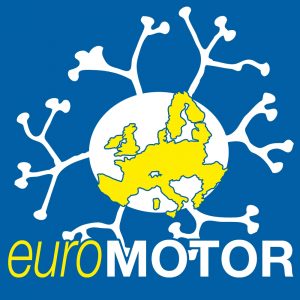The European collaborative EuroMOTOR project has been completed. In this project many ALS centres connected to ENCALS have intensified their collaboration in ALS/ MND research.
The full name of EuroMOTOR is European multidisciplinary ALS network identification to cure motor neuron degeneration.
Objective and outcome
 Most importantly, EuroMOTOR has established that the genetic architecture of ALS is vastly different compared what we had thought 5 years ago: ALS is not as polygenic compared to many other diseases, including Alzheimer’s disease and schizophrenia, but instead is characterized by a distinct rare variant architecture. This has had profound consequences for the ability to apply computational causal modelling in ALS.
Most importantly, EuroMOTOR has established that the genetic architecture of ALS is vastly different compared what we had thought 5 years ago: ALS is not as polygenic compared to many other diseases, including Alzheimer’s disease and schizophrenia, but instead is characterized by a distinct rare variant architecture. This has had profound consequences for the ability to apply computational causal modelling in ALS.
The objective of the Euro-MOTOR project (February 2011 – February 2016) was to discover new causative and disease-modifying pathways to pave the way for novel therapies in Amyotrophic Lateral Sclerosis (ALS). To achieve this goal large-scale quantitative data sets were generated in order to integrate and deliver an ALS computation model.
Data Generation
A shared and harmonized database was set up for which a total of 1818 cases and 3254 controls have been recruited in Ireland, Italy and the Netherlands. Blood samples were collected for ~omics studies, and clinical/environmental/lifestyle data for exposome studies, according to our newly generated European guidelines.
Establishment of In vivo and in vitro ALS models for identification of diagnostic and prognostic biomarkers
Genomics- Instead of identifying genomic loci through genome-wide association studies (GWAS), the ALS rare variant architecture allowed for the identification of “risk genes” through GWAS and whole genome sequencing. In doing so, we have established that C21orf2 and NEK1 are novel ALS risk genes, and that both proteins interact. Also, two additional GWAS loci that may harbour ALS risk genes were replicated.
Proteomics- For protein-protein analysis a quantitative proteomics strategy was developed and employed to investigate the various facets of ALS. We revealed the composition of toxic protein aggregates and provided the first protein inventory of primary motoneurons. Furthermore, we identified pathological changes in patient derived induced pluripotent stem cell (iPS cells) and differentiated motoneurons and assessed the interactome of ALS associated proteins.
Metabolomics- Through the metabolomics analysis of cellular and whole organism models and patient material we have identified common alterations in energy metabolism and other pathways that are associated with ALS and ALS-causing mutations.Transcriptomics- Gene expression profiles (GEPs) of ALS patients were determined and evaluated and established several disease biomarkers, these were cross-compared with cellular and animal models with the previous described genetic, proteomic and metabolomics models.
Exposomics- To determine which potential lifestyle and environmental factors could define ALS susceptibility or phenotype, detailed information was collected and analyzed on clinical, environmental, and lifestyle exposures in the population-based cohorts of ALS patients and matched controls.
Functional studies- Within the Euro-MOTOR project different types of data have been generated to gain insight into the pathology of ALS. In the last phase of the project we developed and applied a methodology to integrate these different datasets and to gain insight into disease mechanisms in ALS. We identified biological pathways and genes that are likely involved in ALS, most notably SNARE activity.
Computational model generation
To replicate above mentioned findings a number of new in vitro (primary and iPS cells) and in vivo (zebrafish and mouse) models were created and used to validate the results. Ephrin signalling, HDAC6, ELP3, lipid/oxygen metabolism and DNA repair were discovered as potential new therapeutic targets for ALS.
SOPs available
The SOPs of the EuroMOTOR project are available on the collaborative projects page.
Meeting reports
ENCALS has previously reported on EuroMOTOR meetings of 2014 and 2015.